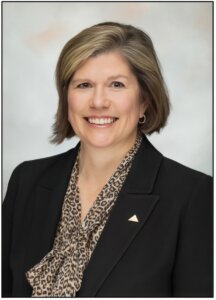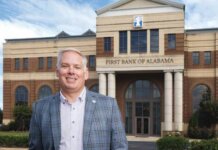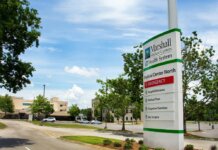
Nonprofit health care organizations are winding through a maze of upcoming Medicaid changes and other current challenges. How do they future-proof their investment portfolios against this backdrop?
Birmingham-based Highland Associates helps these organizations by first understanding their present and future operational needs.
A subsidiary of Regions Financial Corp. since 2019, the firm advises on about $20 billion in assets, according to Highland Group Leader Paige Daniel. The firm serves the investment allocation needs of nonprofit health care entities and mission-based organizations.
Daniel has been with Highland since 2006 and was promoted to her current position in May. As Regions noted at the time, she previously served as head of consulting, guiding Highland’s strategic direction and daily operations. She is a voting member of Highland’s Investment Working Group, which directs all asset allocation and research efforts of the firm.
Highland’s health care clients are situated across the United States and include stand-alone health systems, multistate systems and academic medical centers, Daniel explains.

The Medicaid changes on the horizon are certainly among current clients’ concerns. “The changes in reimbursement really haven’t come into effect yet,” she says, with those expected sometime in 2026. “I think everyone’s just trying to figure out what the potential ramifications could be to policy changes and then looking at expense controls if needed.”
Personnel costs, of course, are also part of the expense landscape for these organizations. “Coming out of COVID, you saw personnel costs move up, especially in nursing. I think that has stabilized from what we’re hearing from clients, and so it’s not a huge drag like it was before,” Daniel notes.
Cybersecurity also is top of mind for Highland’s clients, she says, given the huge rise of hacking and ransomware events over the last few years. Indeed, the topic was central to a July 9 statement by the American Hospital Association to the U.S. Senate Committee on Health, Education, Labor and Pensions’ hearing about enhancing health care cybersecurity.
The statement notes that transnational hacking events have risen nearly tenfold since 2020. Protected health information – PHI – has been stolen during these events, and health care entities have endured ransomware attacks.
In addition, the statement cites data from the U.S. Department of Health and Human Services Office for Civil Rights: Health care data breaches have affected increasing numbers of people, from 27 million in 2020 to 259 million in 2024. Most of the breaches from OCR reports showed hacking incidents were aimed at health care support entities like third-party service and software providers.
Given these cybersecurity threats and new systems needed to thwart them, unease about Medicaid policy changes potentially impacting provider reimbursements and other operational needs and goals, Highland’s clients need guidance on future investments.
Daniel notes the two consecutive years of 25% returns in the U.S. equity markets, along with this year’s “strong rebound.” But, she says: “We probably will see a little bit of a pullback in the market.”
With that volatility and the other challenges heading their way, Highland’s clients are trying to solve the investment puzzle for their organizations.
“I think we’re different in that we want to make sure when we’re managing portfolios, we understand how it ties back to the organization. [We’re] not just looking at, well, we think equities look good or bonds look good, and we don’t really care how they are integrated,” Daniel explains.
One of Highland’s clients was preparing to build a new hospital and had to determine how to fund the construction. The client considered two approaches, Daniel explains. The first was to finance a large portion of the construction via the debt market. The second solution was to use some of the cash available in the organization’s operating portfolio.
“We spent a lot of time trying to understand what the cash needs would be on the portfolio,” Daniel explains. Highland developed a schedule for the client to have cash available monthly across a couple of years.
“That allowed us to take some risk off the table in the portfolio, meaning we sold down some of their equity positions and put [the funds] in more conservative, short-term cash options. It was a nice way to look at how that portfolio would support the overall organization. Again, we’re not looking to structure a portfolio in a vacuum,” Daniel says.
Another Highland client, a health care system, needed support with some operational challenges. The system’s goal was to decrease some of the volatility in its portfolio, Daniel explains. “[The client] wanted to take a little bit of money out of equities and put that into more of a conservative allocation, more on the fixed income side. We worked with them to figure out what that optimal mix needed to be,” says Daniel, who noted that Highland is frequently seeing this type of client need.
Highland had yet another health care client whose portfolio was more strategically focused, with some funds intended for future technology system upgrades and other larger initiatives at the organization. “We helped them devise a plan so that money’s not just sitting in cash,” she explains. Highland “laddered out” the portfolio to ensure specific cash amounts would be available as needed in the future, Daniel says.
Highland’s expertise in health care is one factor that sets it apart from other firms offering similar services, Daniel says. The firm began in 1987 specifically to work with nonprofit health care organizations and help them develop, implement and maintain their investment portfolios.
One of the firm’s founders was a health care chief financial officer, plus the staff included an additional health care CFO. “I think we truly understand the inner workings of the health care industry, and that has certainly grown over the years. That has helped us think very specifically about how the various investment portfolios need to support the organization,” Daniel notes.
The firm views itself as a “boutique,” she says, enabling a more “nimble” approach to investing. “We’ve got sizable money, but we can be very nimble with our investment ideas. [This] also allows us to be very client focused.”
Coupled with its boutique approach is Highland’s position as a Regions subsidiary. This expands the services the firm can offer its health care clients, Daniel says, from commercial banking to treasury management.
Around 20% of Highland’s clients have remained with the firm for 20 years or more, Daniel says. “That is, I think, a strong testament to what we deliver and how we deliver our services here.”
Highland currently has 20 employees serving clients from the East to the West and beyond, Daniel notes. Growth plans are to expand the team, she says, in addition to “actively pursuing” new clients.
“I think that we have a really great value proposition to offer.”
Nancy Randall is a Tuscaloosa-based freelance contributor to Business Alabama.
This article appears in the October 2025 issue of Business Alabama.



